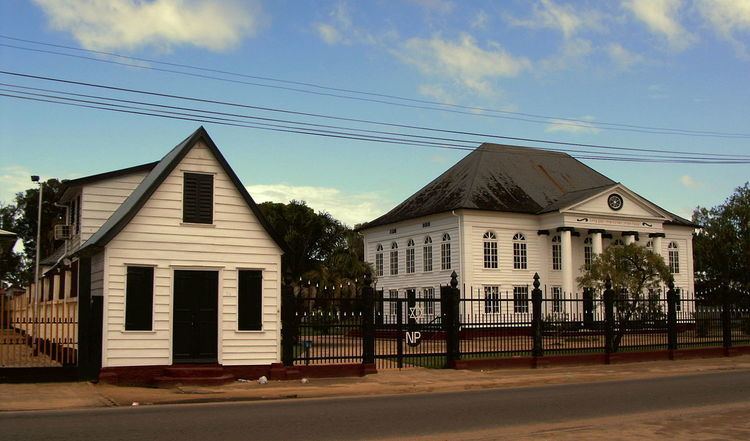 | ||
The history of the Jews in Suriname starts at least in the 17th century, when in 1639, the English government allowed Spanish and Portuguese Jews from the Netherlands, Portugal and Italy to settle the region, coming to the old capital Torarica. In 1652, a new group that migrated under the leadership of Francis Willoughby, 5th Baron Willoughby of Parham came to Suriname and settled in the Jodensavanne area. A third group came 1664, after their expulsion from Recife and then French Guiana, led by David Cohen Nassy.
Contents
In 1799, the British occupied Suriname. Although returned to the Dutch in 1802, the British reoccupied it in May 1804 and did not return it to Holland until 1816. Suriname was one of the most important centers of the Jewish population in the Western Hemisphere, and Jews there were planters and slaveholders.
In a 21st century census 181 answered the "religion" question as "Judaism", out of a total Suriname population of 560,000.
There is a synagogue in Paramaribo, the Neveh Shalom Synagogue.
Synagogues
Three synagogues were built in Suriname: Beracha Ve Shalom (Blessing and Peace) (1685) in the Jodensavanne, an area of savannah that was settled and planted with sugarcane; Neveh Shalom Synagogue (1719) built by Ashkenazi Jews in the new capital of Paramaribo; and Zedek ve Shalom (Justice and Peace) (1735) synagogue built by Sephardice Jews. There was also a Darkhe Yesharim for Judeo African creoles.
The plantation economy of the Jodensavanne used slaves. The community declined in the wake of the French Cassard expedition in 1712 and the levies he instituted; competition from beet sugar; and a revolt by Maroons. Settlers relocated to the capital of Paramaribo. They returned to the synagogue in the Jodensavanne to celebrate the holidays until September 10, 1832, when a fire destroyed the village and synagogue. The savanna area was subsequently overtaken with jungle regrowth.
Depopulation
Most Jews left Suriname when it was granted independence in 1975 and others left during the civil war of the 1980s. About 130 Jewish community members remained in a combined Sephardic and Ashkenazic congregation at Neve Shalom (which includes community hall and mikve). The second synagogue was rented for use as a computer service shop, its furniture and art loaned to the Israel Museum in Jerusalem. In the 1990s, the jungle growth in the Jodensavanne was cleared, 450 graves uncovered and the ruins of the synagogue maintained.
